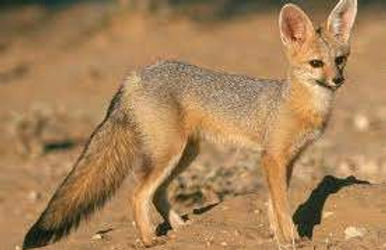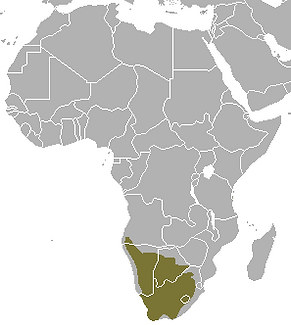Cape Fox(Vulpes chama)
They are also called the asse, cama fox or the silver-backed fox. It is a small-built fox, usually measuring 45-62 cm long, not including its tail, which is typically 30-40 cm. It is 30-35 cm tall at the shoulder, and usually weighs from 2.5-4.5 kg. The ears are relatively large and sharp, the muzzle is small and pointed. Pelage colour is silvery-gray, tawny at the back of the ears, with white hairs appearing around the side of the pinna in the center. The colour of the neck and sides is lighter, and the underparts are pale tawny to pale buff.

The head is dull red and the lower jaw is dark brown. There are white marks on the throat. The legs are more tawny than the rest of the body. The tail is dense and bushy, and can be silvery, pale fawn, buff with brown or black tips, or dull yellow. The tail tip is always black, and there's a dark spot over the caudal gland. Pelage is soft and composed of a thick wavy underfur of around 25 mm in length. Underfur is covered with a dense layer of guard hair < 40 mm in thickness. Molt occurs in the wet season from October to November. There is little to no sexual dimorphism.
Habitat
It primarily occupies arid and semi-arid areas, but in sections, such as the fynbos biome of the western Cape Province of South Africa, the species reaches areas of higher rainfall and denser vegetation. In the central and western regions of southern Africa, the species is widespread, reaching around 15 ° N in south-western Angola. It is widespread in Zimbabwe, Botswana, and South Africa, occurring in most parts of the Western and Northern Cape provinces, the Eastern Cape (excluding the southeastern side), the Free State, western and northwestern KwaZulu-Natal and the North-West province. It also occurs in Lesotho, a high mountainous region.

Diet
Cape foxes are completely omnivorous and opportunists, feeding mainly on small mammals (such as rodents) and insects, but also commonly eating birds, small reptiles, carrion and fruits. Other food items include: gerbils; field mice and other small rodents, hares, birds; bird nestlings and eggs, diverse vegetable material, including wild fruit, berries, seeds, roots, and tubers; lizards, insects, such as white ants, beetles and their larvae, and locusts. They may also consume larger mammals like steenbok and other carnivores such as the yellow mongoose. While Cape foxes have been reported to kill livestock, the predation level is unknown. Domestic sheep may comprise as much as 16.6% volume of its stomach content, but it appears to prey only on very young lambs (less than 3 months old), otherwise they can only consume it as carrion. They are known to cache food in holes.
Breeding
Cape foxes are monogamous animals and a pair mates for life. They breed at any time of the year, although they generally give birth from October to January. The gestation period is 51 to 53 days and one to six cubs are born. The litter is reared underground in burrows, and the cubs will remain close by the den until about four months old. At about six to eight weeks they are weaned, but they do not start to forage until the age of four months. Cubs are usually independent by five months when they will leave the den, generally around June or July. Both parents rear the young, and during the first two weeks after birth, the male will also provide for the female. Sexual maturity is reached at nine months old.
Population
According to the IUCN Red List, they are classed as Least Concern(LC). Generally common to fairly abundant across much of its range, although problem animal control activities have resulted in population reductions in some areas. Estimates are only available for South Africa's Free State province where an average density of 0.3 foxes per km² was estimated with a total population of 31,000 individuals. Annual offtake resulting from problem animal control programmes averaged roughly 16% up to 1985, with no obvious declines in overall populations. Range and numbers have increased in the south-west and east of South Africa. Estimated population sizes or numbers are not available, but it is thought that populations are currently stable across their entire range.
Threats
There are no major threats to the species. Habitat loss/changes are not a major factor influencing the conservation status of the Cape Fox. In fact, in western Cape Province and elsewhere, changing agricultural practices have resulted in range extensions for this species, as well as for the Bat-eared Fox . Expansion of semi-arid karroid vegetation during the process of desertification, especially eastwards, has also resulted in range extensions of this canid. Heavy direct and indirect problem animal control measures do not seem to have had a major impact on populations of the Cape Fox, even though they have resulted in declines in some areas. The illegal but widespread and indiscriminate use of agricultural poisons on commercial farms poses the main threat.
Conservation
Not listed in the CITES Appendices. Occurs in many protected areas across its range, including a number of provincial and private nature reserves, as well as on game ranches in all South African provinces, although the species has a much more restricted range in Limpopo Province and KwaZulu-Natal. In Swaziland, the species may occur in Nhlangano Nature Reserve in the south-west and pups have been successfully reared in Milwane Game Reserve. Although treated as a problem animal across most of its range, it is partially protected in several South African provinces, as it does not appear on the official lists of problem species. However, no permit is required from any authority to kill this fox in problem animal control operations. No protection measures are currently enforced and at the present time, this is not necessary. Although the Cape Fox has been extensively studied in South Africa's Free State province, there is little information available elsewhere within its range. Aspects such as diet and reproduction are quite well known, but little information is available on aspects of social ecology and behaviour in the wild. Some investigation into the role, if any, this species plays in disease transmission is necessary.